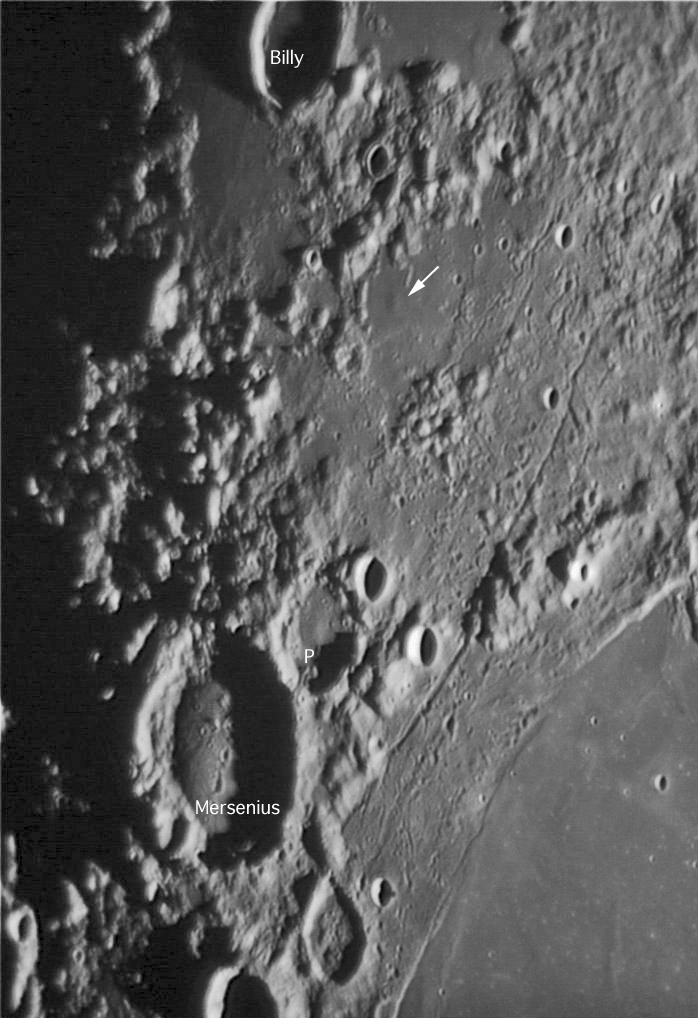Difference between revisions of "LPOD Feb 15, 2008"
| Line 1: | Line 1: | ||
<div id="content_view" class="wiki" style="display: block"> | <div id="content_view" class="wiki" style="display: block"> | ||
=ANOTHER CORNER= | =ANOTHER CORNER= | ||
| − | <br /> [[Image:LPOD-Feb15-08.jpg|LPOD-Feb15-08.jpg]]<br /> ''image by [mailto:rafaelbenpal@gmail.com Rafael Benavides,] Posadas, Córdoba, Spain''<br /> <br /> Rafael has had fabulous luck with Humorum. He has captured excellent images of the [[LPOD%20Feb%207%2C%202008|southeast]] and [[LPOD%20Feb%208%2C%202008|southwest]] corners of the basin, and now the northwest. His images are low Sun closeups of the region between the maria and outer basin rings. This is typically a swampy area where ejecta, mountain rings and localized puddles of mare lava intermix. And that is what is here, with a variety of rilles, mostly heading northwards. There are also some domes. The biggest definite dome is on the floor of Mersenius P, indicated by its slightly bright sun-facing slope matched with a slightly dusky shadowed side. A somewhat smaller dome (arrow) occurs to the north on the lava-covered floor of a possible ruined crater. Although these two domes look very similar a glance at the Clementine UVVIS multi-spectral [http://www.mapaplanet.org/explorer-bin/explorer.cgi?map=Moon&layers=moon_clementine_multi&west=306.23&south=-20.62&east=317.48&north=-15.00¢er=311.855&defaultcenter=on&grid=none&stretch=none&projection=SIMP&advoption=NO&info=NO&resolution=64 mosaic] shows that the smaller dome formed on dark mare material, but the one in P is on mare-looking stuff that is covered with bright ejecta - it is probably the older of the two domes. A third, possible larger dome is hinted at on the floor of Mersenius, just above the "M". This one occurs where there are many thin rilles and the Clementine image shows a volcanic dark halo at about the same spot. Is it a real dome?<br /> <br /> ''Chuck Wood''<br /> <br /> '''Technical Details'''<br /> Jan 19, 2008. Celestron 11 + Barlow 2X + Luna-QHY 5 mono camera. <br /> Today's LPOD is just a piece of a larger [http://img111.imageshack.us/img111/9282/gassendiopik9.jpg image.]<br /> <br /> '''Related Links'''<br /> Rükl plate<br /> Rafael's [http://algieba.blogalia.com/ website]<br /> <br /> '''[[LPOD%20Index|Index]] of past LPOD's'''<br /> <br /> | + | <br /> [[Image:LPOD-Feb15-08.jpg|LPOD-Feb15-08.jpg]]<br /> ''image by [mailto:rafaelbenpal@gmail.com Rafael Benavides,] Posadas, Córdoba, Spain''<br /> <br /> Rafael has had fabulous luck with Humorum. He has captured excellent images of the [[LPOD%20Feb%207%2C%202008|southeast]] and [[LPOD%20Feb%208%2C%202008|southwest]] corners of the basin, and now the northwest. His images are low Sun closeups of the region between the maria and outer basin rings. This is typically a swampy area where ejecta, mountain rings and localized puddles of mare lava intermix. And that is what is here, with a variety of rilles, mostly heading northwards. There are also some domes. The biggest definite dome is on the floor of Mersenius P, indicated by its slightly bright sun-facing slope matched with a slightly dusky shadowed side. A somewhat smaller dome (arrow) occurs to the north on the lava-covered floor of a possible ruined crater. Although these two domes look very similar a glance at the Clementine UVVIS multi-spectral [http://www.mapaplanet.org/explorer-bin/explorer.cgi?map=Moon&layers=moon_clementine_multi&west=306.23&south=-20.62&east=317.48&north=-15.00¢er=311.855&defaultcenter=on&grid=none&stretch=none&projection=SIMP&advoption=NO&info=NO&resolution=64 mosaic] shows that the smaller dome formed on dark mare material, but the one in P is on mare-looking stuff that is covered with bright ejecta - it is probably the older of the two domes. A third, possible larger dome is hinted at on the floor of Mersenius, just above the "M". This one occurs where there are many thin rilles and the Clementine image shows a volcanic dark halo at about the same spot. Is it a real dome?<br /> <br /> ''Chuck Wood''<br /> <br /> '''Technical Details'''<br /> Jan 19, 2008. Celestron 11 + Barlow 2X + Luna-QHY 5 mono camera. <br /> Today's LPOD is just a piece of a larger [http://img111.imageshack.us/img111/9282/gassendiopik9.jpg image.]<br /> <br /> '''Related Links'''<br /> Rükl plate<br /> Rafael's [http://algieba.blogalia.com/ website]<br /> <br /> '''[[LPOD%20Index|Index]] of past LPOD's'''<br /> <br /> <br /> <br /> </div> |
Latest revision as of 13:38, 15 April 2018
ANOTHER CORNER

image by Rafael Benavides, Posadas, Córdoba, Spain
Rafael has had fabulous luck with Humorum. He has captured excellent images of the southeast and southwest corners of the basin, and now the northwest. His images are low Sun closeups of the region between the maria and outer basin rings. This is typically a swampy area where ejecta, mountain rings and localized puddles of mare lava intermix. And that is what is here, with a variety of rilles, mostly heading northwards. There are also some domes. The biggest definite dome is on the floor of Mersenius P, indicated by its slightly bright sun-facing slope matched with a slightly dusky shadowed side. A somewhat smaller dome (arrow) occurs to the north on the lava-covered floor of a possible ruined crater. Although these two domes look very similar a glance at the Clementine UVVIS multi-spectral mosaic shows that the smaller dome formed on dark mare material, but the one in P is on mare-looking stuff that is covered with bright ejecta - it is probably the older of the two domes. A third, possible larger dome is hinted at on the floor of Mersenius, just above the "M". This one occurs where there are many thin rilles and the Clementine image shows a volcanic dark halo at about the same spot. Is it a real dome?
Chuck Wood
Technical Details
Jan 19, 2008. Celestron 11 + Barlow 2X + Luna-QHY 5 mono camera.
Today's LPOD is just a piece of a larger image.
Related Links
Rükl plate
Rafael's website
Index of past LPOD's